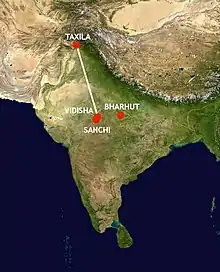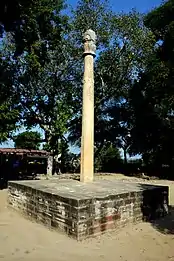Heliodorus (ambassador)
Heliodorus (Greek: Ἡλιόδωρος) was an Indo-Greek ambassador sent to the court of King Bhagabhadra by Antialcidas (Indo-Greek King of Taxila) in 113 B.C. He is known for building a pillar called the "Khamb Baba" or "Heliodorus Pillar" which still exists in Vidisha, India near Bhopal, India.[1][2]
Heliodurus converted to Hinduism and built a pillar which states the following (translation from the Journal of the Royal Asiatic Society - London: JRAS, Pub., 1909, pp. 1053–54.) in ancient Brahmi text:
This Garuda column of Vasudeva (Vishnu), the god of gods, was erected here by Heliodorus, a worshiper of Vishnu, the son of Dion, and an inhabitant of Taxila, who came as Greek ambassador from the Great King Antialkidas to King Kasiputra Bhagabhadra, the Savior, then reigning prosperously in the fourteenth year of his kingship. Three important precepts when practiced lead to heaven: self-restraint, charity, conscientiousness.
The first modern-time Western observation of the column was by Major General Alexander Cunningham K.B.E in 1877. However, Sir Cunningham did not notice the inscriptions on the pillar, which were later discovered in 1901 by another British archaeologist.[2]
Even most local people are unaware of the existence and the historical significance of this pillar.
References
- Hermann Kulke and Dietmar Rothermund (2004). A History of India. Routledge. p. 73. ISBN 0-415-32920-5.
- Shaw, Julia (31 August 2013). Buddhist Landscapes in Central India: Sanchi Hill and Archaeologies of Religious and Social Change, C. Third Century BC to Fifth Century AD. Left Coast Press. pp. 21–22. ISBN 978-1-61132-344-3.

